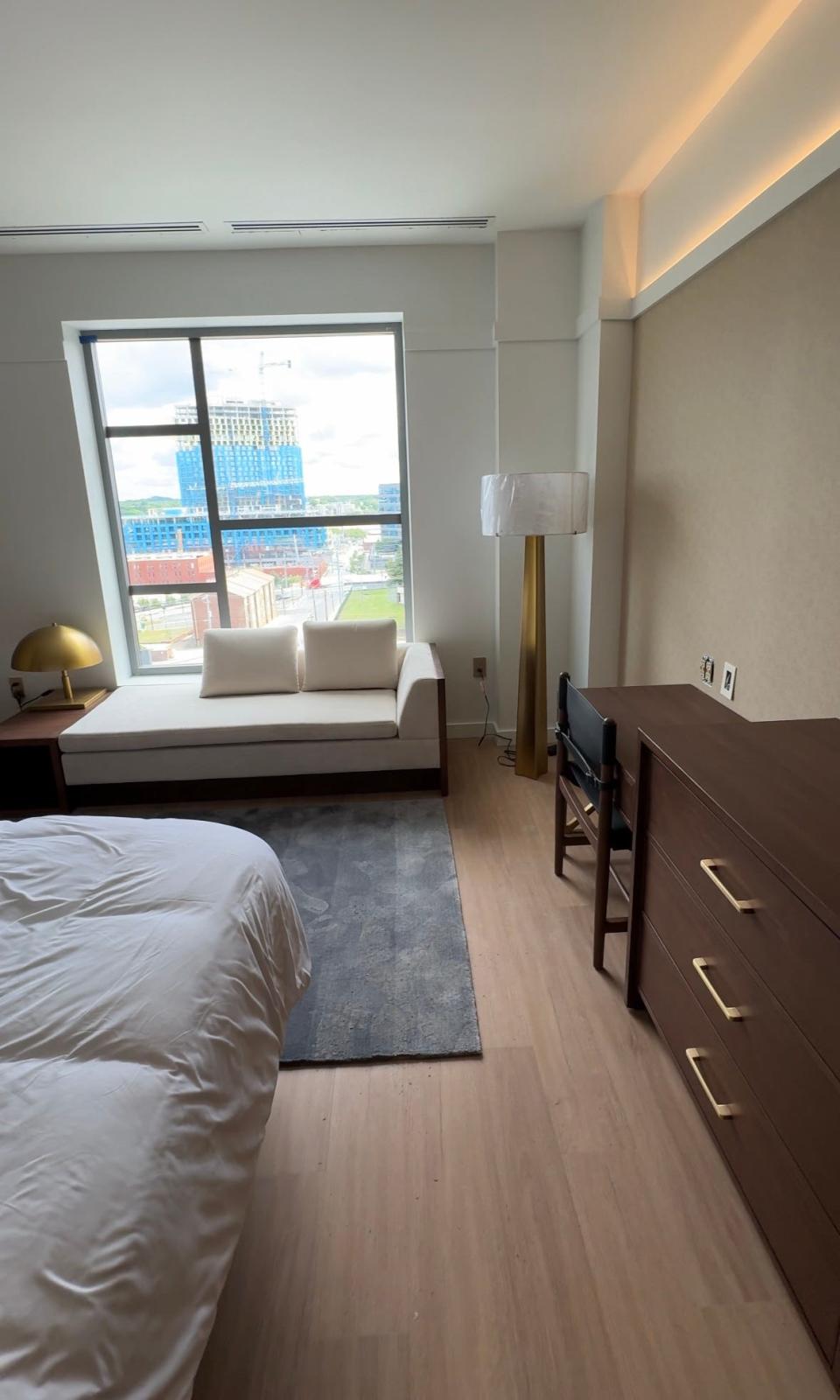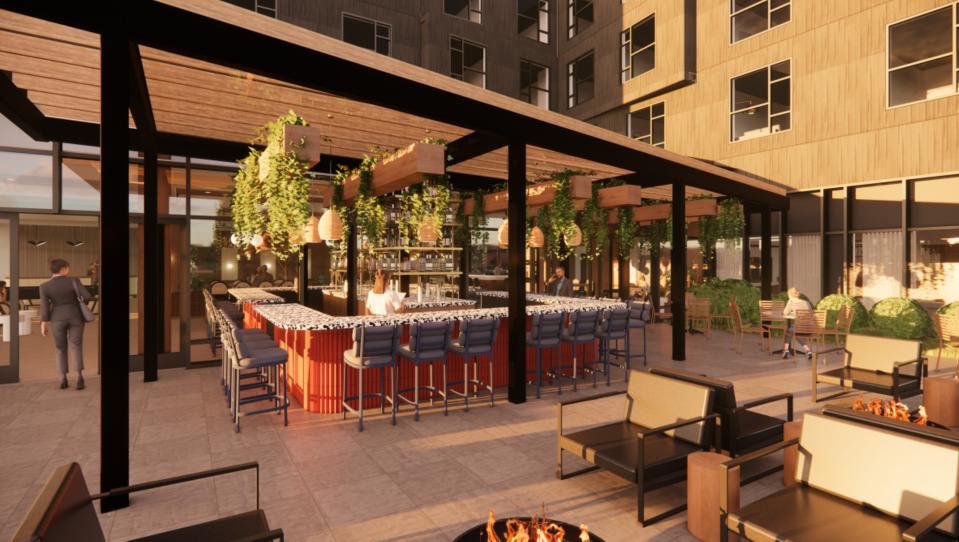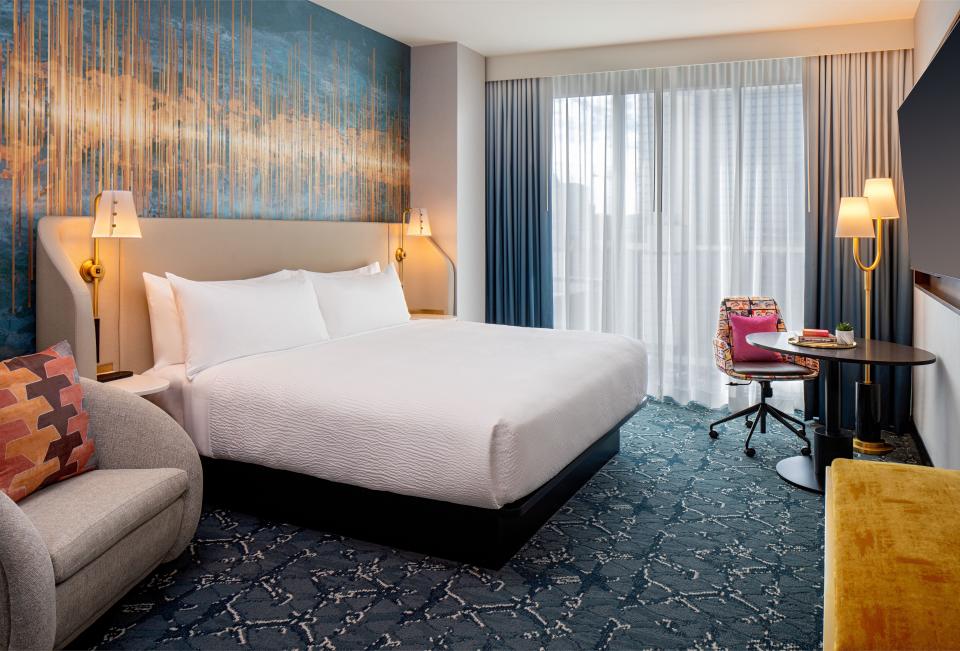How are hotel rooms designed? Here's how Hilton gets guest spaces check-in ready.
As I walked down the halls of the upcoming Printing House Downtown Nashville, Tennessee, hotel, I stepped around cardboard boxes and cables. But as I entered a guest room on the 11th floor in late April as part of a hard hat tour, the dusty concrete floors gave way to clean, wide planks of hardwood.
The space featured a bed with a backlit headboard, a desk and matching chair in a walnut finish, and brass midcentury accents. While the rest of the Tapestry Collection by Hilton property – expected to open in August – was still a construction site, this room looked nearly finished.
That’s part of Hilton’s hotel room design process. The company often creates models of the spaces on site to test them out well before guests arrive. “You don't want to fix a mistake or something that you may have overlooked 300 times,” Larry Traxler, senior vice president of global Design at Hilton, told USA TODAY. “It's better to do it once in that model room stage, which is why they're so important.”
But that’s just one of many steps that go into getting a hotel room ready for check-in.

How are Hilton hotel rooms designed?
That depends on the type of property. Hilton’s megacategory brands – such as the budget-friendly Spark or the extended-stay LivSmart Studios – are designed using brand prototypes.
“We'll build model rooms, we'll prototype (furniture, fixtures and equipment),” said Traxler. “We’ll build 15 versions of a chair, a lounge chair, or the bed headboard, and work through all the details and select the best one.”
For many other hotels – ranging from DoubleTree to luxury brands like Waldorf Astoria Hotels & Resorts – Traxler said “everything is bespoke.”
They start with the most typical rooms – usually king and double rooms, which constitute the widest array – “because if we can really detail that room well, that will solve the most case uses throughout the hotel.” The designs can then be tweaked as needed for other categories like suites or to accommodate factors such as column locations.
Once they have the first layouts, they begin “layering in color (and) materials,” which may differ depending on the property’s location.
“For instance, if we're designing for a seaside coastal location, we're going to approach design very differently than we would for a mountain resort location, and very different than an airport location where the average length of stay may be one night,” Traxler said.
The team also considers guest expectations and the brand identity. Hilton has brand standards that every hotel must meet, but there is creative wiggle room within those parameters.
The Printing House, for example, takes inspiration from the history of Nashville’s printing industry. In the early 1900s, Printers Alley – located less than a mile from the hotel – serviced 13 publishers and 10 printers, and the city is home to the legendary Hatch Show Print letterpress print shop, which has been operating since 1879.

That theme will be evident throughout the property. The guest rooms will feature custom Hatch Show Print artwork, while the hotel’s tile and finish patterns incorporate a geometric stamp design – as do panels on its exterior – among other touches.
Jenna Hackett, Hilton’s senior vice president of Lifestyle Brand Management, said at properties like the Printing House, a hotel room “needs to be a continuation of the story.”
How long do hotel rooms take to design?
Getting a model room design down on paper can take six to 12 months. Procuring the product can take an additional two to six months, as many of the pieces are custom. “You know, they have to make the carpet, they make the light fixtures,” Traxler said. (Renovation design typically moves faster than a new construction project.)
Model rooms are then constructed on-site if the project is far enough along or at an offsite warehouse. In the latter cases, they try to replicate the setting of the actual hotel. “We would build the plumbing riser, the structural bay would be exactly the same, the window size,” he said. They also work to replicate the lighting and adhere to film the window to give a sense of the view guests would see.
The installation takes around three to four weeks. “Then we move in, and we tear it apart,” he said.
They thoroughly test the room to see if anything doesn’t work, from the door swings to the power outlet locations. If the model room is in a hotel, they even stay overnight when possible to see how it looks at different times of day.
Where do Hilton hotels get their furniture?
Nearly all the furniture Hilton uses in its hotel rooms is custom-built. “We almost never buy things running stock unless we're in a pinch,” Traxler said.
The furniture is tailored to the room. The items may also be smaller than those found in a residential setting “because our rooms and our hotels are frequently asked to do more than our bedrooms at home – unless we live in a studio apartment in Manhattan.”

How have hotel room designs changed?
As the way guests use hotel rooms changes, so do the room designs. Access to power for electronic devices, for instance, is crucial. “Five years ago, it was important, but now it's imperative,” said Traxler.
They also consider how travelers often use hotel rooms as secondary offices and take Zoom calls during their stays. “So, we have to think about (the) backdrop and what does it look like within that guest room, and how do we create a seamless way of having somebody use that room without having to make their bed and put all of their luggage away?”
The “added social nature of how rooms are being used today” may mean occupants find a settee for two rather than a single lounge chair. The company is also thinking about how to offer more fitness and wellness opportunities (some Tempo by Hilton hotel rooms feature Peloton bikes, for example).
Do you want an early hotel check-in?: Here's what is happening behind the scenes
“If you're with 200 people at a conference, you may not feel comfortable heading down to the gym at 7 o'clock before the 9 o'clock start, but you want to get something in,” Traxler said.
Guest expectations are also high today, he added, regardless of what kind of hotel they’re staying in.
“It doesn’t matter if they're spending $500 or $5,000 a night, they demand good light, they demand thoughtful art, they demand nice textures and a comfortable seat,” he said. Traxler attributed that to social media and how word travels if a hotel room is not up to par.
That raises the bar on the design. “It's gotten harder, but it's also gotten a lot more fun.”
The reporter on this story received access to this event from Hilton. USA TODAY maintains editorial control of content.
Nathan Diller is a consumer travel reporter for USA TODAY based in Nashville. You can reach him at ndiller@usatoday.com.
This article originally appeared on USA TODAY: More than a bedroom: How Hilton hotel rooms are designed


